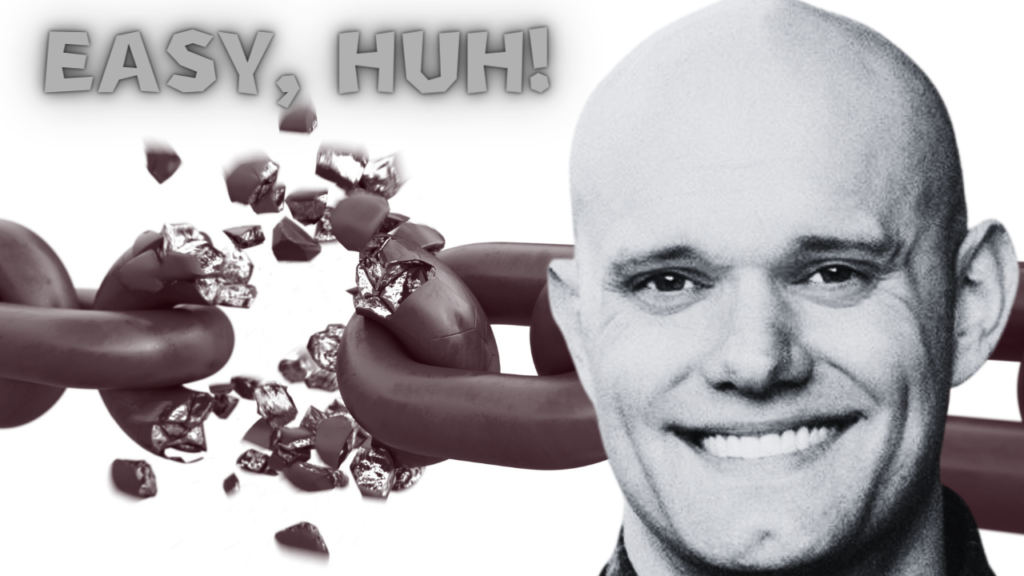Introduction:
Have you ever struggled to break a bad habit? Do you genuinely want to know how to break a bad habit? Well, bookbutter’s friend, look no further because this article is precisely what you need! We’ve got the tips, tricks, and techniques to help you break that habit once and for all. So, buckle up and get ready to bid farewell to that pesky habit holding you back from reaching your full potential.
Habits are a fundamental aspect of human behavior, influencing everything from our productivity and health to our relationships and success. Good habits can help us achieve our goals and live a fulfilling life, while bad habits can hold us back and cause a great deal of stress and frustration.
If you’re reading this, chances are you’re looking for ways to break a bad habit and make a positive change in your life. Whether you’re trying to quit smoking, stop procrastinating, or break a pattern of negative thinking, breaking a bad habit can be challenging. But don’t worry – with the right strategies and mindset, it’s definitely possible. You can also check this article on A Step-by-Step Guide to Achieving Your Goals.
One of the most effective approaches to breaking bad habits is the concept of “Atomic Habits,” which emphasizes the power of small, incremental changes over time. In this article, we’ll explore how you can use the principles of Atomic Habits to break bad habits and create positive change in your life. We’ll cover everything from understanding the root of bad habits to practical strategies for breaking them, as well as habits that can change your life for the better. So let’s get started!
If you want to know How to Break a Bad Habit, you can read this blog post about Building Atomic Habits: A Step-by-Step Guide to Achieving Your Goals
Understanding Bad Habits
Bad habits are behaviors or patterns that are harmful or counterproductive to your goals, health, or well-being. They can range from seemingly small habits like biting your nails or checking your phone constantly to more serious habits like smoking, overeating, or procrastination.
Bad habits form through a process known as “habituation,” which involves the repetition of a behavior in response to a certain cue or trigger. Over time, the behavior becomes automatic and ingrained in your brain, making it difficult to break the habit without conscious effort and intervention.
The negative effects of bad habits can be far-reaching and can impact every area of your life. For example, a habit of procrastination can cause you to miss deadlines, feel stressed and overwhelmed, and damage your professional reputation. A habit of overeating can lead to weight gain, health problems, and low self-esteem. This article explains in detail the habit loop and how it can affect your power to overcome bad habits.
Breaking a bad habit requires a deep understanding of its underlying causes and triggers. In the next section, we’ll discuss practical strategies for identifying and breaking bad habits using the principles of Atomic Habits.
How to Break Bad Habits
Breaking a bad habit can be challenging, but with the right strategies and mindset, it’s definitely possible. Here are some practical tips and strategies for breaking bad habits:
- Identify triggers: Identify the situations, people, or emotions that trigger your bad habit. Once you understand your triggers, you can take steps to avoid or manage them.
- Create a plan: Create a plan for breaking your bad habit, including specific actions you’ll take to replace the habit with a healthier behavior. For example, if you want to quit smoking, your plan might include using nicotine patches or gum, finding a support group, and avoiding situations where you’re likely to smoke.
- Track your progress: Keep track of your progress using a journal or habit tracker. Celebrate your successes and learn from your setbacks.
- Practice self-compassion: Be kind to yourself throughout the process of breaking a bad habit. Remember that change takes time and effort, and setbacks are a natural part of the process.
- Stay consistent and persistent: Breaking a bad habit requires consistent effort and persistence. Keep showing up every day and making small, incremental changes.
By following these tips and strategies, you can break your bad habit and create positive change in your life. Remember that the key to success is to stay focused, stay positive, and never give up. You can also check this detailed article Overcoming Plateaus: How to Keep Making Progress with Your Habits.
Habits That Will Change Your Life
Breaking a bad habit is just the first step towards creating positive change in your life. To truly transform your life, it’s important to adopt new, positive habits that can help you become the best version of yourself. Here are some examples of habits that can have a significant impact on your life:
- Exercise: Regular exercise can improve your physical and mental health, boost your energy levels, and reduce stress and anxiety. Aim to exercise for at least 30 minutes a day, whether it’s through walking, running, yoga, or any other physical activity you enjoy.
- Meditation: Practicing meditation can help you reduce stress, increase your focus and concentration, and improve your overall well-being. Start with just a few minutes of meditation each day and gradually increase the duration as you become more comfortable with the practice.
- Reading: Reading can expand your knowledge, improve your vocabulary, and enhance your creativity. Make it a habit to read for at least 20 minutes a day, whether it’s a book, magazine, or online article.
You can read this article to find out 10 Habits for a Successful Morning Routine to Boost Your Personal and Financial Development. To incorporate these habits into your daily routine, start small and gradually build up over time. For example, you could start by exercising for 10 minutes a day, meditating for 5 minutes a day, and reading for 10 minutes a day. As you become more comfortable with these habits, increase the time gradually until they become a natural part of your daily routine.
By adopting positive habits like exercise, meditation, and reading, you can create positive change in your life and become the best version of yourself. If you would like to read more about this you can check out this blog post.
How Long Does It Take to Break a Bad Habit?
Breaking a bad habit is a process that requires patience and persistence. It’s natural to wonder how long it will take to break a habit, but the answer varies from person to person and depends on several factors, such as the nature of the habit, the individual’s motivation and mindset, and the level of support and resources available. We have already explained this in a great details in this article: The Science of Habit Formation: How to Create and Break Habits.
Research suggests that it takes an average of 66 days to form a new habit or break an old one, but this timeline can vary widely. Some people may see significant progress in just a few days or weeks, while others may struggle for months or even years to overcome a stubborn habit. You can also check out this blog post The Four-Step Process for Creating Good Habits: An Infographic Overview.
One reason for this variability is that habits are deeply ingrained in our brains and bodies. They involve a complex network of neural pathways, triggers, and rewards that can be difficult to rewire or replace. Moreover, habits often serve a psychological or emotional purpose, such as reducing stress or providing comfort, which can make them harder to give up.
However, the good news is that with the right approach, it’s possible to break any habit over time. Some tips for staying motivated and committed to the process include:
- Set specific, measurable goals: Rather than just trying to “stop” a bad habit, set clear goals for what you want to achieve instead. For example, if you want to quit smoking, you might aim to go for a week without a cigarette, then gradually increase the time frame. This blog post explains this strategy in details: The Power of Small Habits: How Tiny Changes Can Lead to Big Results (Book Summary).
- Identify triggers and replacement behaviors: Pay attention to what triggers your bad habit and try to replace it with a healthier or more positive behavior. For instance, if you tend to snack on junk food when you’re bored, try going for a walk or calling a friend instead.
- Practice self-compassion: Be kind to yourself when you slip up or have a setback. Recognize that breaking a habit is a challenging process and that progress often comes in fits and starts.
- Get support: Surround yourself with people who encourage and support your efforts to break a bad habit. Join a support group, talk to a friend, or seek professional help if needed.
- Track your progress: Keep a record of your successes and challenges, and celebrate your milestones along the way. This can help you stay motivated and focused on your goals.
Breaking a bad habit is a process that takes time and effort, but it’s well worth it for the positive impact it can have on your life. Remember to be patient and persistent, and don’t hesitate to seek help or support when you need it. If you are interested, you can also checkout this blog post about The Four-Step Process for Creating Good Habits: An Infographic Overview.
How to Break Bad Eating Habits (With an Example and a Detailed Plan)
Bad eating habits can be particularly challenging to break, as they often involve deeply ingrained patterns of behavior and can be influenced by a variety of factors, such as stress, boredom, or social pressure. However, with dedication and persistence, it is possible to make significant changes in your eating habits and improve your overall health and wellbeing. Here are some tips and strategies for breaking bad eating habits:
- Identify triggers: Start by paying attention to what triggers your unhealthy eating habits. Do you reach for junk food when you’re stressed? Do you overeat when you’re bored? Once you know what triggers your unhealthy eating habits, you can work on avoiding or managing those triggers.
- Create a meal plan: Planning your meals in advance can help you make healthier choices and avoid impulsive decisions. Make a list of healthy foods you enjoy and create a weekly meal plan that incorporates these foods. When you go grocery shopping, stick to your list and avoid buying unhealthy foods.
- Practice mindful eating: Mindful eating involves paying attention to your body’s hunger and fullness signals and being fully present during meals. Eat slowly, savoring each bite, and stop eating when you feel satisfied, not stuffed. Avoid distractions like TV or your phone during meals.
- Seek support: Breaking bad eating habits can be challenging, so it’s important to have a support system in place. This could be a friend or family member who is also working on improving their eating habits, or a professional like a nutritionist or therapist.
- Stay positive and patient: Breaking bad eating habits takes time and effort, so be patient with yourself and stay positive. Celebrate your successes, no matter how small, and don’t give up if you slip up. Remember that every day is a new opportunity to make healthier choices.
Detailed Plan:
- Identify your bad eating habits: Take some time to reflect on your eating habits and identify which ones are unhealthy. Examples of bad eating habits could include eating too quickly, snacking late at night, or eating when you’re not hungry.
- Set specific goals: Once you’ve identified your bad eating habits, set specific goals for how you want to change them. For example, you could aim to eat a healthy breakfast every day, or to avoid eating after 8 pm.
- Create a meal plan: Plan your meals for the week, taking into account your specific goals and the healthy foods you enjoy. Make a grocery list and stick to it when you go shopping.
- Practice mindful eating: Be fully present during meals and pay attention to your body’s hunger and fullness signals. Eat slowly and savor each bite, avoiding distractions like TV or your phone.
- Find support: Seek support from friends, family, or a professional if needed. Consider joining a support group or finding an accountability partner to help you stay motivated.
- Stay positive and patient: Breaking bad eating habits takes time and effort, so be patient with yourself and stay positive. Celebrate your successes, no matter how small, and don’t give up if you slip up. Remember that every day is a new opportunity to make healthier choices.
While understanding habits is valuable, one way to learn how to break a bad habit is to track your progress and understand where you stand. A habit tracker and habit-change workbook can help you track your habit change effectively. We offer the best habit tracker and habit-change workbook in the market, which you can download for free from here. Check it out to start breaking your bad habits today.
To Sum Up
In conclusion, breaking bad habits can be a difficult but rewarding process. In Section 1, we learned how habits are formed and the importance of self-awareness in identifying and addressing bad habits. In Section 2, we explored effective strategies for breaking bad habits, such as replacing them with healthier alternatives and setting achievable goals. Section 3 highlighted the positive habits that can have a significant impact on our lives, such as exercise, meditation, and reading.
We also answered the common question of how long it takes to break a bad habit in Section 4, and provided tips for staying motivated and committed to breaking bad habits for the long term. Finally, in Section 5, we provided specific tips and strategies for breaking bad eating habits, such as meal planning, mindful eating, and seeking support from others.
This article explores 10 Habits for a Successful Morning Routine to Boost Your Personal and Financial Development.
Remember that breaking bad habits is a process that requires effort, patience, and commitment. Small changes can lead to big results over time, and it’s never too late to start. We encourage you to take action and start breaking your bad habits today. By implementing the strategies and tips discussed in this article, you can create positive changes in your life and achieve your goals.
To gain a better understanding of this concept, we invite you to watch our informative video on our channel. Our video provides an in-depth explanation of this topic and can help you grasp the importance of differentiating between assets and liabilities. Our channel offers an array of book summaries and reviews, including financial and personal development books, making it the perfect resource for those seeking to improve their financial literacy and personal growth. Visit our channel to discover the best book summaries and reviews available online.
Discover effective techniques for breaking bad habits with our curated topics! Learn how to break a bad habit with these valuable resources. Start your journey towards self-improvement and positive change today.
- Atomic Habits – How to Break a Bad Habit
- How to Break a Bad Habit – A complete Guide
- How to Break a Bad Habit and Change Your Life
- Breaking Bad Habits: Understanding the Habit Loop for Lasting Change
- 10 Habits for a Successful Morning Routine to Boost Your Personal and Financial Development
- Overcoming Plateaus: How to Keep Making Progress with Your Habits
- Building Atomic Habits: A Step-by-Step Guide to Achieving Your Goals
- The Science of Habit Formation: How to Create and Break Habits
- The Power of Small Habits: How Tiny Changes Can Lead to Big Results (Book Summary)
- The Four-Step Process for Creating Good Habits: An Infographic Overview
- Atomic Habits Full Audiobook in English by James Clear – Complete Free Audiobook




Pingback: How to Break a Bad Habit – A complete Guide – Book Butter
Pingback: Atomic Habits - How to Break a Bad Habit - Book Butter